Reflective Journal: Entrepreneurship Module Reflections and Analysis
VerifiedAdded on 2022/12/28
|9
|2813
|24
Journal and Reflective Writing
AI Summary
This reflective journal analyzes the learning outcomes of an Innovation, Creativity, and Entrepreneurship course. The student reflects on the importance of creativity and innovation, situational analysis, and financial projections within entrepreneurship. The journal covers the core modules, including fundamental concepts of innovation, creativity in organizational processes, customer-centric design, product development, business plan elements, sources of finance, and organizational management. The student discusses the entrepreneurial process, customer satisfaction, product development, and the importance of strategic planning, financing, and employee engagement. The reflection highlights the application of course concepts to real-world scenarios and personal business interests, emphasizing the need for a structured approach to entrepreneurship, customer focus, and sustainable business practices. The journal concludes with a reflection on assignments and the application of learned concepts to the student's family business of organic farming, focusing on new products and distribution channels.
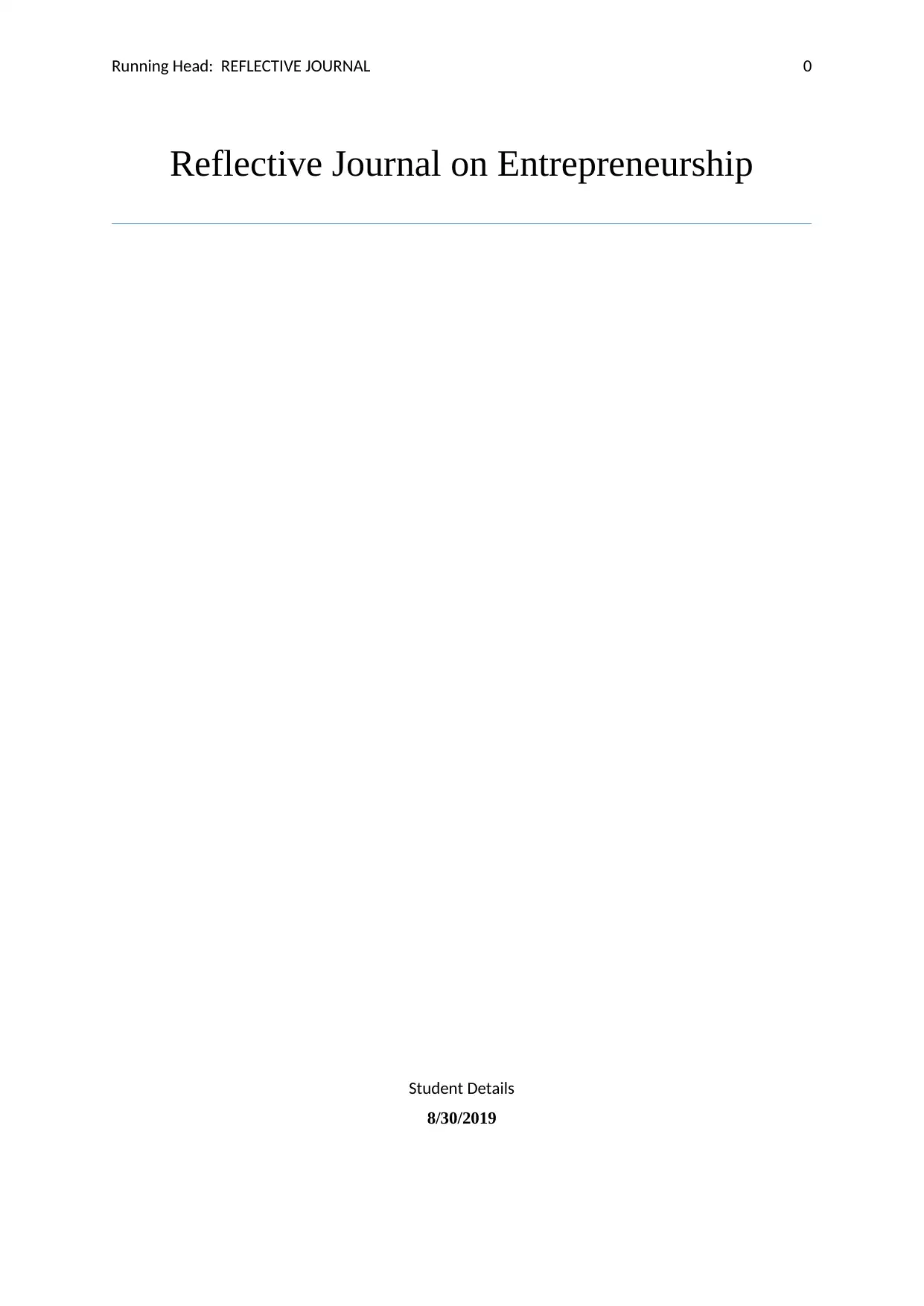
Running Head: REFLECTIVE JOURNAL 0
Reflective Journal on Entrepreneurship
Student Details
8/30/2019
Reflective Journal on Entrepreneurship
Student Details
8/30/2019
Paraphrase This Document
Need a fresh take? Get an instant paraphrase of this document with our AI Paraphraser
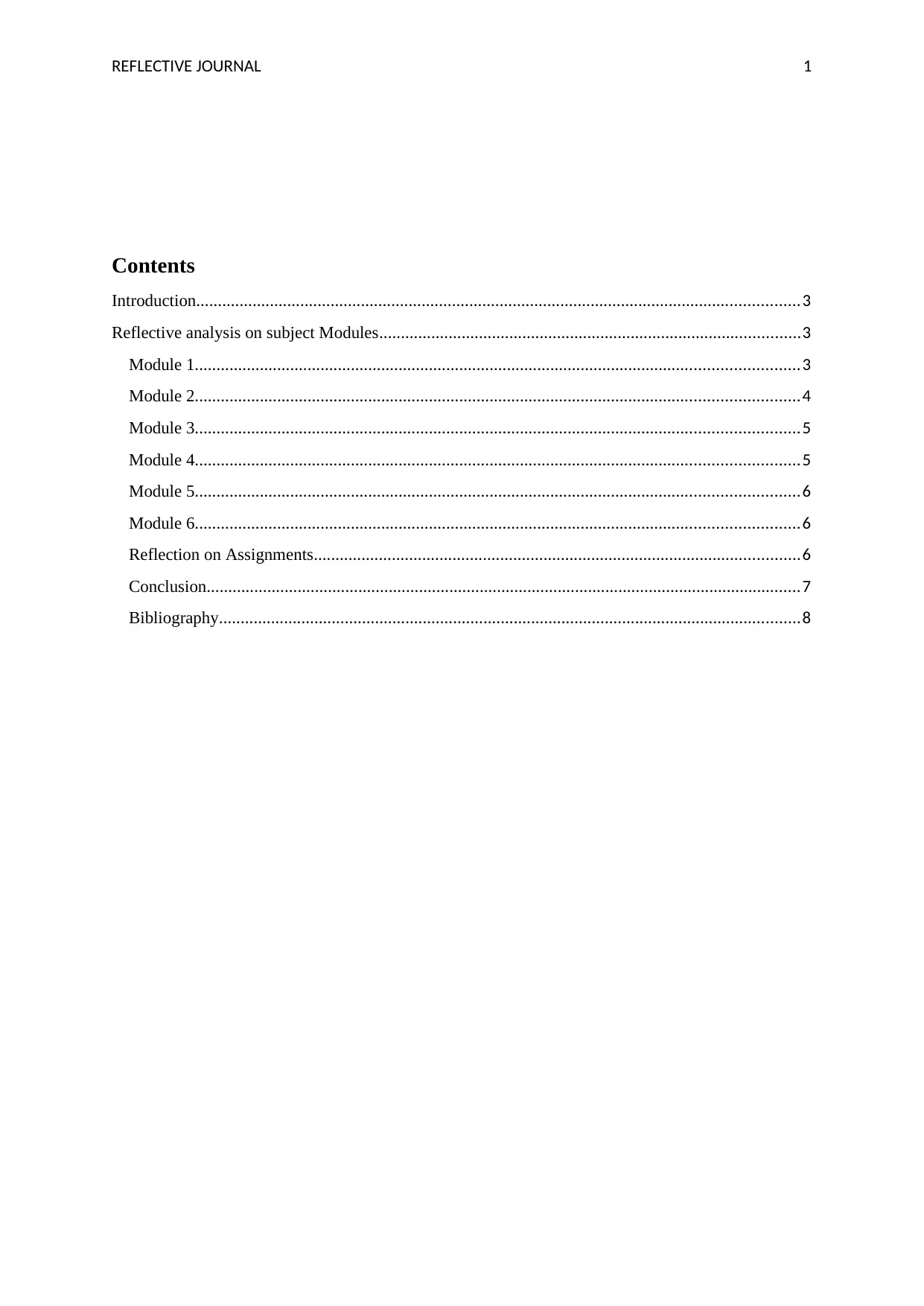
REFLECTIVE JOURNAL 1
Contents
Introduction...........................................................................................................................................3
Reflective analysis on subject Modules.................................................................................................3
Module 1...........................................................................................................................................3
Module 2...........................................................................................................................................4
Module 3...........................................................................................................................................5
Module 4...........................................................................................................................................5
Module 5...........................................................................................................................................6
Module 6...........................................................................................................................................6
Reflection on Assignments................................................................................................................6
Conclusion.........................................................................................................................................7
Bibliography......................................................................................................................................8
Contents
Introduction...........................................................................................................................................3
Reflective analysis on subject Modules.................................................................................................3
Module 1...........................................................................................................................................3
Module 2...........................................................................................................................................4
Module 3...........................................................................................................................................5
Module 4...........................................................................................................................................5
Module 5...........................................................................................................................................6
Module 6...........................................................................................................................................6
Reflection on Assignments................................................................................................................6
Conclusion.........................................................................................................................................7
Bibliography......................................................................................................................................8
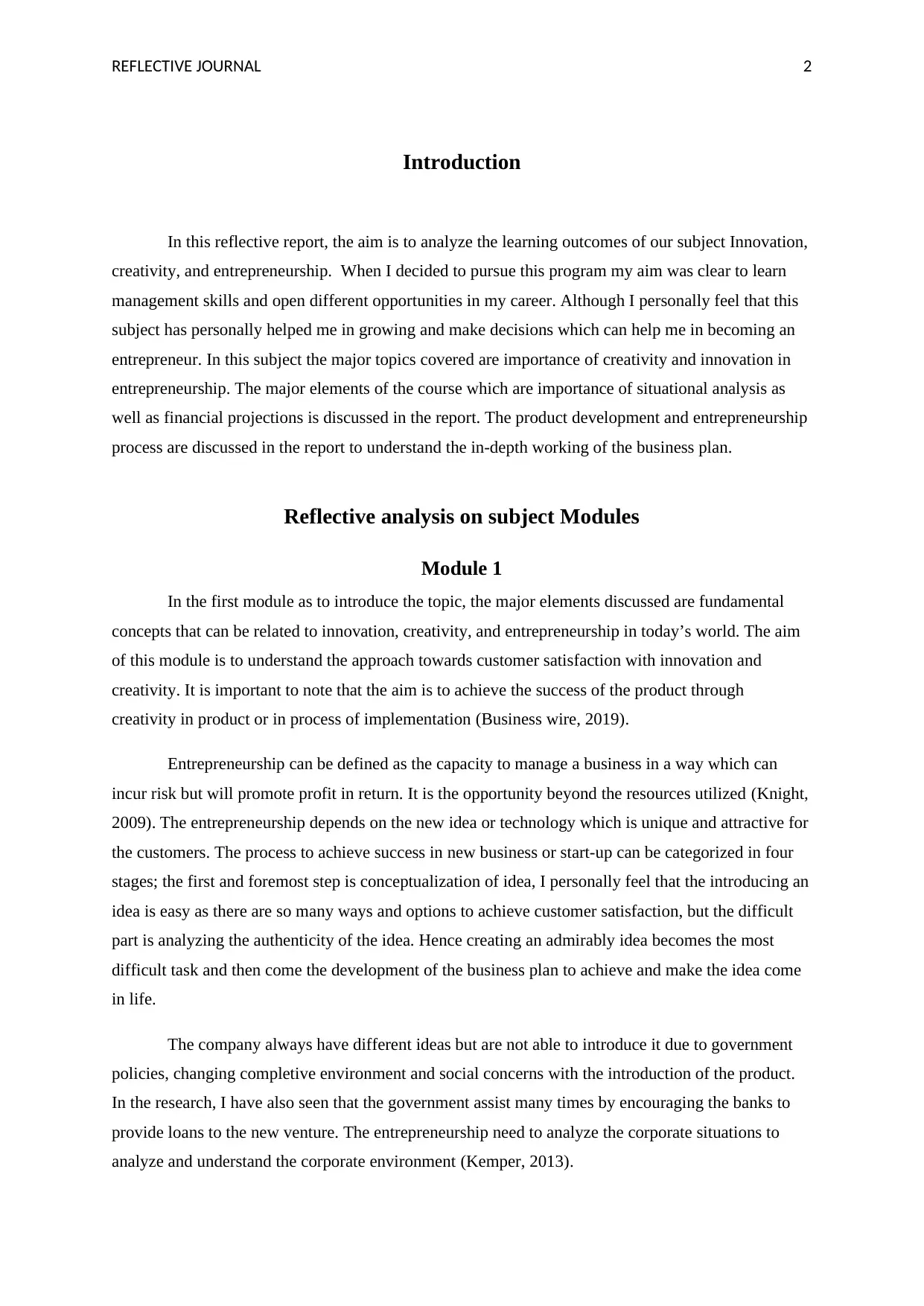
REFLECTIVE JOURNAL 2
Introduction
In this reflective report, the aim is to analyze the learning outcomes of our subject Innovation,
creativity, and entrepreneurship. When I decided to pursue this program my aim was clear to learn
management skills and open different opportunities in my career. Although I personally feel that this
subject has personally helped me in growing and make decisions which can help me in becoming an
entrepreneur. In this subject the major topics covered are importance of creativity and innovation in
entrepreneurship. The major elements of the course which are importance of situational analysis as
well as financial projections is discussed in the report. The product development and entrepreneurship
process are discussed in the report to understand the in-depth working of the business plan.
Reflective analysis on subject Modules
Module 1
In the first module as to introduce the topic, the major elements discussed are fundamental
concepts that can be related to innovation, creativity, and entrepreneurship in today’s world. The aim
of this module is to understand the approach towards customer satisfaction with innovation and
creativity. It is important to note that the aim is to achieve the success of the product through
creativity in product or in process of implementation (Business wire, 2019).
Entrepreneurship can be defined as the capacity to manage a business in a way which can
incur risk but will promote profit in return. It is the opportunity beyond the resources utilized (Knight,
2009). The entrepreneurship depends on the new idea or technology which is unique and attractive for
the customers. The process to achieve success in new business or start-up can be categorized in four
stages; the first and foremost step is conceptualization of idea, I personally feel that the introducing an
idea is easy as there are so many ways and options to achieve customer satisfaction, but the difficult
part is analyzing the authenticity of the idea. Hence creating an admirably idea becomes the most
difficult task and then come the development of the business plan to achieve and make the idea come
in life.
The company always have different ideas but are not able to introduce it due to government
policies, changing completive environment and social concerns with the introduction of the product.
In the research, I have also seen that the government assist many times by encouraging the banks to
provide loans to the new venture. The entrepreneurship need to analyze the corporate situations to
analyze and understand the corporate environment (Kemper, 2013).
Introduction
In this reflective report, the aim is to analyze the learning outcomes of our subject Innovation,
creativity, and entrepreneurship. When I decided to pursue this program my aim was clear to learn
management skills and open different opportunities in my career. Although I personally feel that this
subject has personally helped me in growing and make decisions which can help me in becoming an
entrepreneur. In this subject the major topics covered are importance of creativity and innovation in
entrepreneurship. The major elements of the course which are importance of situational analysis as
well as financial projections is discussed in the report. The product development and entrepreneurship
process are discussed in the report to understand the in-depth working of the business plan.
Reflective analysis on subject Modules
Module 1
In the first module as to introduce the topic, the major elements discussed are fundamental
concepts that can be related to innovation, creativity, and entrepreneurship in today’s world. The aim
of this module is to understand the approach towards customer satisfaction with innovation and
creativity. It is important to note that the aim is to achieve the success of the product through
creativity in product or in process of implementation (Business wire, 2019).
Entrepreneurship can be defined as the capacity to manage a business in a way which can
incur risk but will promote profit in return. It is the opportunity beyond the resources utilized (Knight,
2009). The entrepreneurship depends on the new idea or technology which is unique and attractive for
the customers. The process to achieve success in new business or start-up can be categorized in four
stages; the first and foremost step is conceptualization of idea, I personally feel that the introducing an
idea is easy as there are so many ways and options to achieve customer satisfaction, but the difficult
part is analyzing the authenticity of the idea. Hence creating an admirably idea becomes the most
difficult task and then come the development of the business plan to achieve and make the idea come
in life.
The company always have different ideas but are not able to introduce it due to government
policies, changing completive environment and social concerns with the introduction of the product.
In the research, I have also seen that the government assist many times by encouraging the banks to
provide loans to the new venture. The entrepreneurship need to analyze the corporate situations to
analyze and understand the corporate environment (Kemper, 2013).
⊘ This is a preview!⊘
Do you want full access?
Subscribe today to unlock all pages.

Trusted by 1+ million students worldwide
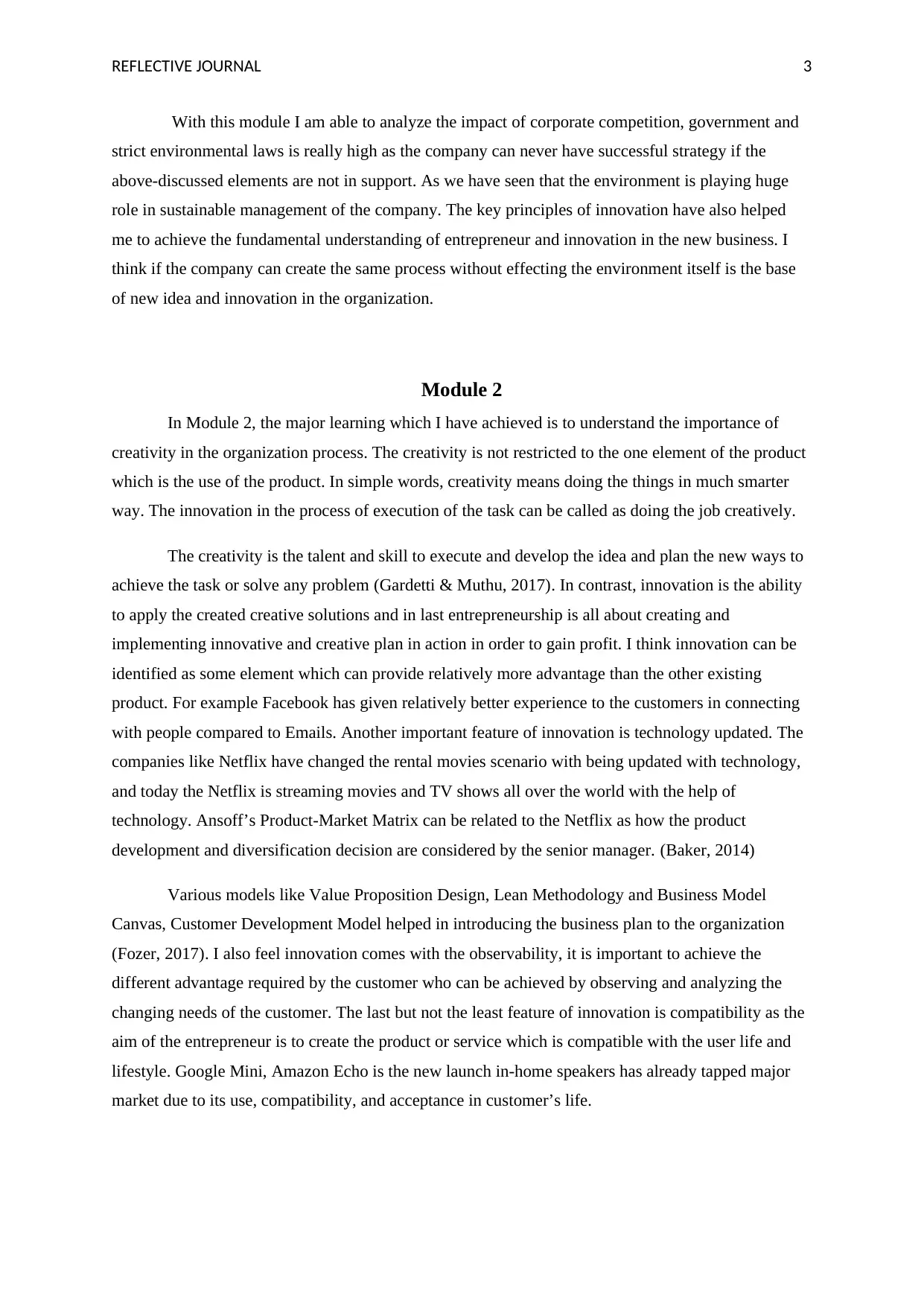
REFLECTIVE JOURNAL 3
With this module I am able to analyze the impact of corporate competition, government and
strict environmental laws is really high as the company can never have successful strategy if the
above-discussed elements are not in support. As we have seen that the environment is playing huge
role in sustainable management of the company. The key principles of innovation have also helped
me to achieve the fundamental understanding of entrepreneur and innovation in the new business. I
think if the company can create the same process without effecting the environment itself is the base
of new idea and innovation in the organization.
Module 2
In Module 2, the major learning which I have achieved is to understand the importance of
creativity in the organization process. The creativity is not restricted to the one element of the product
which is the use of the product. In simple words, creativity means doing the things in much smarter
way. The innovation in the process of execution of the task can be called as doing the job creatively.
The creativity is the talent and skill to execute and develop the idea and plan the new ways to
achieve the task or solve any problem (Gardetti & Muthu, 2017). In contrast, innovation is the ability
to apply the created creative solutions and in last entrepreneurship is all about creating and
implementing innovative and creative plan in action in order to gain profit. I think innovation can be
identified as some element which can provide relatively more advantage than the other existing
product. For example Facebook has given relatively better experience to the customers in connecting
with people compared to Emails. Another important feature of innovation is technology updated. The
companies like Netflix have changed the rental movies scenario with being updated with technology,
and today the Netflix is streaming movies and TV shows all over the world with the help of
technology. Ansoff’s Product-Market Matrix can be related to the Netflix as how the product
development and diversification decision are considered by the senior manager. (Baker, 2014)
Various models like Value Proposition Design, Lean Methodology and Business Model
Canvas, Customer Development Model helped in introducing the business plan to the organization
(Fozer, 2017). I also feel innovation comes with the observability, it is important to achieve the
different advantage required by the customer who can be achieved by observing and analyzing the
changing needs of the customer. The last but not the least feature of innovation is compatibility as the
aim of the entrepreneur is to create the product or service which is compatible with the user life and
lifestyle. Google Mini, Amazon Echo is the new launch in-home speakers has already tapped major
market due to its use, compatibility, and acceptance in customer’s life.
With this module I am able to analyze the impact of corporate competition, government and
strict environmental laws is really high as the company can never have successful strategy if the
above-discussed elements are not in support. As we have seen that the environment is playing huge
role in sustainable management of the company. The key principles of innovation have also helped
me to achieve the fundamental understanding of entrepreneur and innovation in the new business. I
think if the company can create the same process without effecting the environment itself is the base
of new idea and innovation in the organization.
Module 2
In Module 2, the major learning which I have achieved is to understand the importance of
creativity in the organization process. The creativity is not restricted to the one element of the product
which is the use of the product. In simple words, creativity means doing the things in much smarter
way. The innovation in the process of execution of the task can be called as doing the job creatively.
The creativity is the talent and skill to execute and develop the idea and plan the new ways to
achieve the task or solve any problem (Gardetti & Muthu, 2017). In contrast, innovation is the ability
to apply the created creative solutions and in last entrepreneurship is all about creating and
implementing innovative and creative plan in action in order to gain profit. I think innovation can be
identified as some element which can provide relatively more advantage than the other existing
product. For example Facebook has given relatively better experience to the customers in connecting
with people compared to Emails. Another important feature of innovation is technology updated. The
companies like Netflix have changed the rental movies scenario with being updated with technology,
and today the Netflix is streaming movies and TV shows all over the world with the help of
technology. Ansoff’s Product-Market Matrix can be related to the Netflix as how the product
development and diversification decision are considered by the senior manager. (Baker, 2014)
Various models like Value Proposition Design, Lean Methodology and Business Model
Canvas, Customer Development Model helped in introducing the business plan to the organization
(Fozer, 2017). I also feel innovation comes with the observability, it is important to achieve the
different advantage required by the customer who can be achieved by observing and analyzing the
changing needs of the customer. The last but not the least feature of innovation is compatibility as the
aim of the entrepreneur is to create the product or service which is compatible with the user life and
lifestyle. Google Mini, Amazon Echo is the new launch in-home speakers has already tapped major
market due to its use, compatibility, and acceptance in customer’s life.
Paraphrase This Document
Need a fresh take? Get an instant paraphrase of this document with our AI Paraphraser
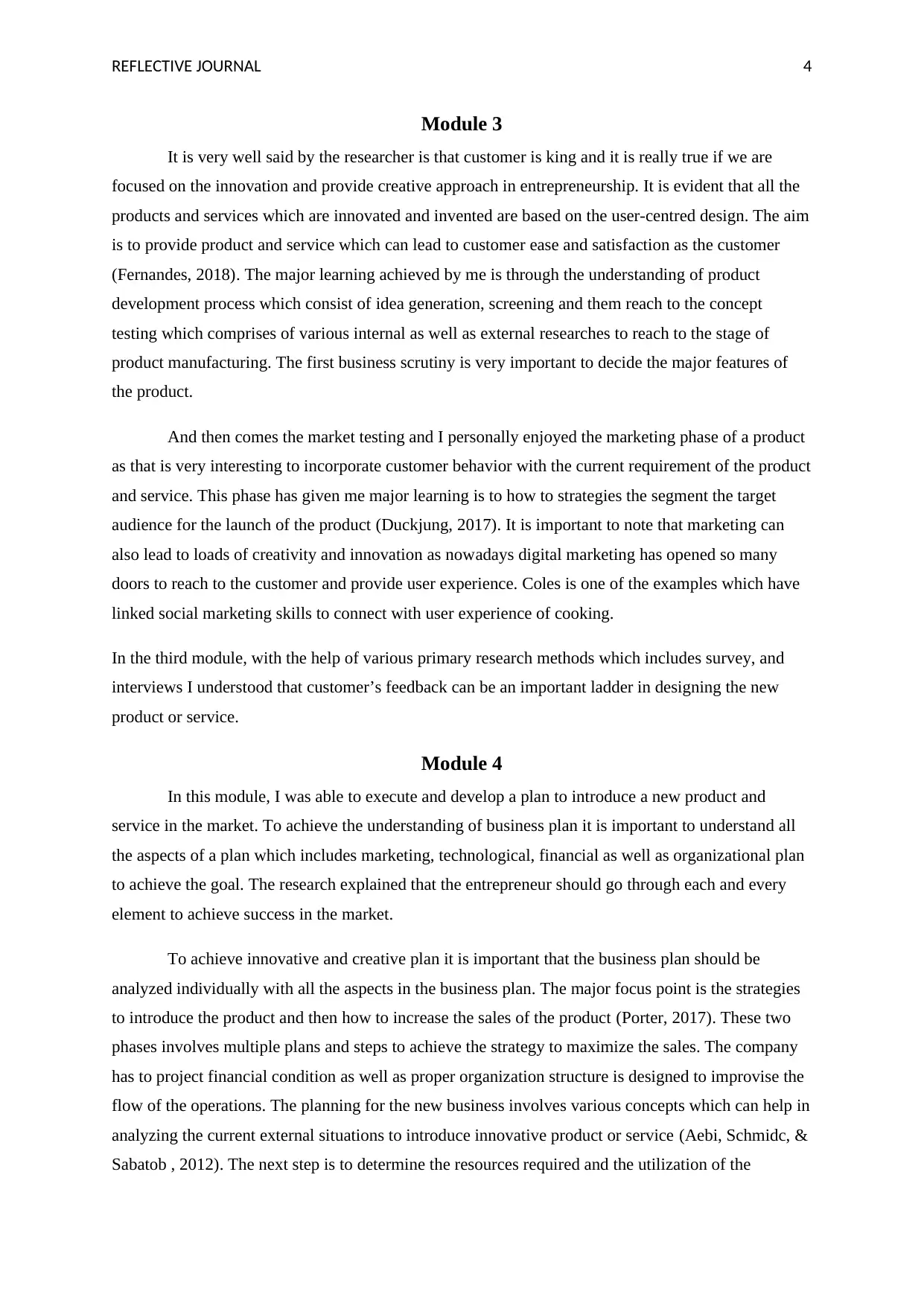
REFLECTIVE JOURNAL 4
Module 3
It is very well said by the researcher is that customer is king and it is really true if we are
focused on the innovation and provide creative approach in entrepreneurship. It is evident that all the
products and services which are innovated and invented are based on the user-centred design. The aim
is to provide product and service which can lead to customer ease and satisfaction as the customer
(Fernandes, 2018). The major learning achieved by me is through the understanding of product
development process which consist of idea generation, screening and them reach to the concept
testing which comprises of various internal as well as external researches to reach to the stage of
product manufacturing. The first business scrutiny is very important to decide the major features of
the product.
And then comes the market testing and I personally enjoyed the marketing phase of a product
as that is very interesting to incorporate customer behavior with the current requirement of the product
and service. This phase has given me major learning is to how to strategies the segment the target
audience for the launch of the product (Duckjung, 2017). It is important to note that marketing can
also lead to loads of creativity and innovation as nowadays digital marketing has opened so many
doors to reach to the customer and provide user experience. Coles is one of the examples which have
linked social marketing skills to connect with user experience of cooking.
In the third module, with the help of various primary research methods which includes survey, and
interviews I understood that customer’s feedback can be an important ladder in designing the new
product or service.
Module 4
In this module, I was able to execute and develop a plan to introduce a new product and
service in the market. To achieve the understanding of business plan it is important to understand all
the aspects of a plan which includes marketing, technological, financial as well as organizational plan
to achieve the goal. The research explained that the entrepreneur should go through each and every
element to achieve success in the market.
To achieve innovative and creative plan it is important that the business plan should be
analyzed individually with all the aspects in the business plan. The major focus point is the strategies
to introduce the product and then how to increase the sales of the product (Porter, 2017). These two
phases involves multiple plans and steps to achieve the strategy to maximize the sales. The company
has to project financial condition as well as proper organization structure is designed to improvise the
flow of the operations. The planning for the new business involves various concepts which can help in
analyzing the current external situations to introduce innovative product or service (Aebi, Schmidc, &
Sabatob , 2012). The next step is to determine the resources required and the utilization of the
Module 3
It is very well said by the researcher is that customer is king and it is really true if we are
focused on the innovation and provide creative approach in entrepreneurship. It is evident that all the
products and services which are innovated and invented are based on the user-centred design. The aim
is to provide product and service which can lead to customer ease and satisfaction as the customer
(Fernandes, 2018). The major learning achieved by me is through the understanding of product
development process which consist of idea generation, screening and them reach to the concept
testing which comprises of various internal as well as external researches to reach to the stage of
product manufacturing. The first business scrutiny is very important to decide the major features of
the product.
And then comes the market testing and I personally enjoyed the marketing phase of a product
as that is very interesting to incorporate customer behavior with the current requirement of the product
and service. This phase has given me major learning is to how to strategies the segment the target
audience for the launch of the product (Duckjung, 2017). It is important to note that marketing can
also lead to loads of creativity and innovation as nowadays digital marketing has opened so many
doors to reach to the customer and provide user experience. Coles is one of the examples which have
linked social marketing skills to connect with user experience of cooking.
In the third module, with the help of various primary research methods which includes survey, and
interviews I understood that customer’s feedback can be an important ladder in designing the new
product or service.
Module 4
In this module, I was able to execute and develop a plan to introduce a new product and
service in the market. To achieve the understanding of business plan it is important to understand all
the aspects of a plan which includes marketing, technological, financial as well as organizational plan
to achieve the goal. The research explained that the entrepreneur should go through each and every
element to achieve success in the market.
To achieve innovative and creative plan it is important that the business plan should be
analyzed individually with all the aspects in the business plan. The major focus point is the strategies
to introduce the product and then how to increase the sales of the product (Porter, 2017). These two
phases involves multiple plans and steps to achieve the strategy to maximize the sales. The company
has to project financial condition as well as proper organization structure is designed to improvise the
flow of the operations. The planning for the new business involves various concepts which can help in
analyzing the current external situations to introduce innovative product or service (Aebi, Schmidc, &
Sabatob , 2012). The next step is to determine the resources required and the utilization of the
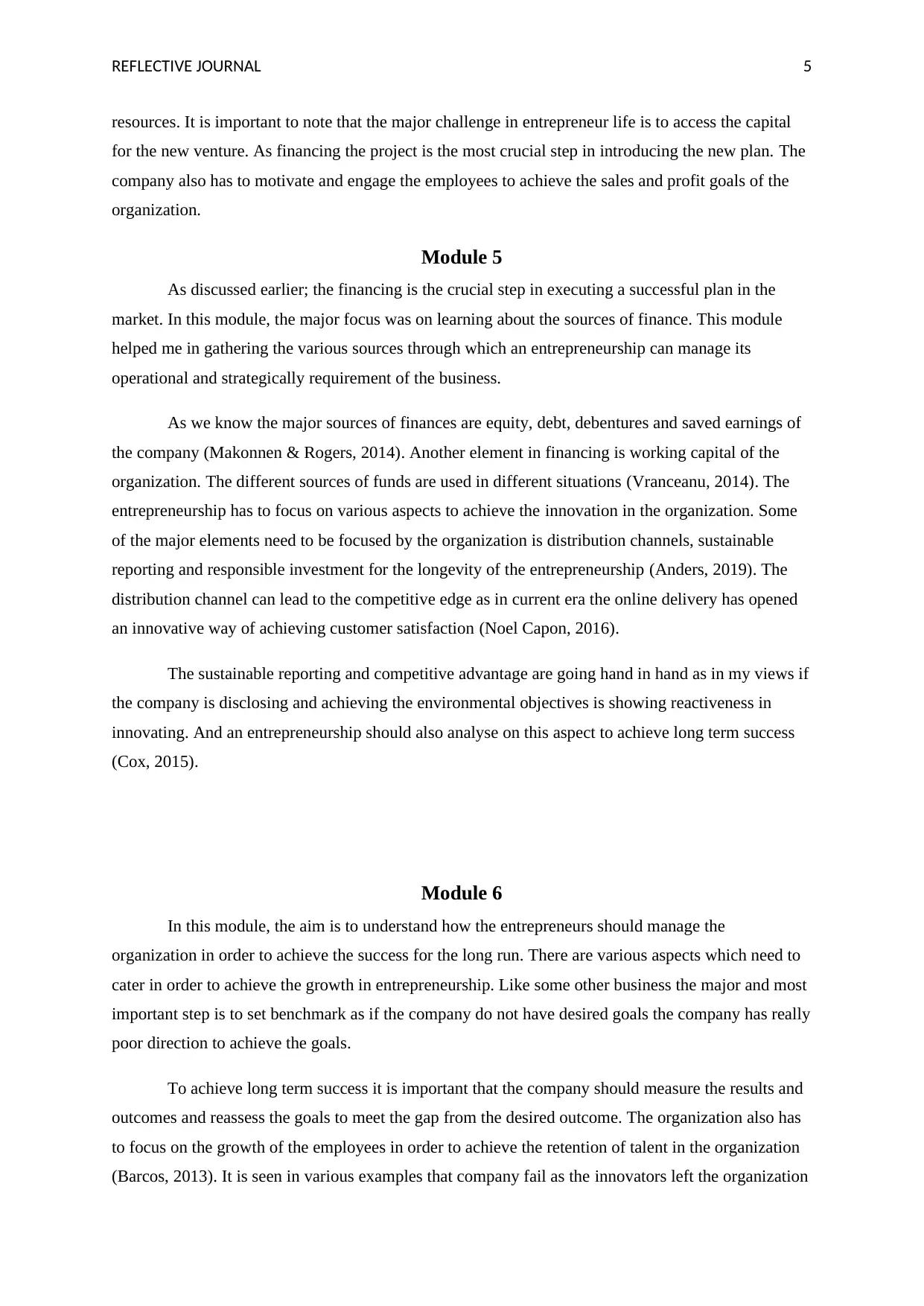
REFLECTIVE JOURNAL 5
resources. It is important to note that the major challenge in entrepreneur life is to access the capital
for the new venture. As financing the project is the most crucial step in introducing the new plan. The
company also has to motivate and engage the employees to achieve the sales and profit goals of the
organization.
Module 5
As discussed earlier; the financing is the crucial step in executing a successful plan in the
market. In this module, the major focus was on learning about the sources of finance. This module
helped me in gathering the various sources through which an entrepreneurship can manage its
operational and strategically requirement of the business.
As we know the major sources of finances are equity, debt, debentures and saved earnings of
the company (Makonnen & Rogers, 2014). Another element in financing is working capital of the
organization. The different sources of funds are used in different situations (Vranceanu, 2014). The
entrepreneurship has to focus on various aspects to achieve the innovation in the organization. Some
of the major elements need to be focused by the organization is distribution channels, sustainable
reporting and responsible investment for the longevity of the entrepreneurship (Anders, 2019). The
distribution channel can lead to the competitive edge as in current era the online delivery has opened
an innovative way of achieving customer satisfaction (Noel Capon, 2016).
The sustainable reporting and competitive advantage are going hand in hand as in my views if
the company is disclosing and achieving the environmental objectives is showing reactiveness in
innovating. And an entrepreneurship should also analyse on this aspect to achieve long term success
(Cox, 2015).
Module 6
In this module, the aim is to understand how the entrepreneurs should manage the
organization in order to achieve the success for the long run. There are various aspects which need to
cater in order to achieve the growth in entrepreneurship. Like some other business the major and most
important step is to set benchmark as if the company do not have desired goals the company has really
poor direction to achieve the goals.
To achieve long term success it is important that the company should measure the results and
outcomes and reassess the goals to meet the gap from the desired outcome. The organization also has
to focus on the growth of the employees in order to achieve the retention of talent in the organization
(Barcos, 2013). It is seen in various examples that company fail as the innovators left the organization
resources. It is important to note that the major challenge in entrepreneur life is to access the capital
for the new venture. As financing the project is the most crucial step in introducing the new plan. The
company also has to motivate and engage the employees to achieve the sales and profit goals of the
organization.
Module 5
As discussed earlier; the financing is the crucial step in executing a successful plan in the
market. In this module, the major focus was on learning about the sources of finance. This module
helped me in gathering the various sources through which an entrepreneurship can manage its
operational and strategically requirement of the business.
As we know the major sources of finances are equity, debt, debentures and saved earnings of
the company (Makonnen & Rogers, 2014). Another element in financing is working capital of the
organization. The different sources of funds are used in different situations (Vranceanu, 2014). The
entrepreneurship has to focus on various aspects to achieve the innovation in the organization. Some
of the major elements need to be focused by the organization is distribution channels, sustainable
reporting and responsible investment for the longevity of the entrepreneurship (Anders, 2019). The
distribution channel can lead to the competitive edge as in current era the online delivery has opened
an innovative way of achieving customer satisfaction (Noel Capon, 2016).
The sustainable reporting and competitive advantage are going hand in hand as in my views if
the company is disclosing and achieving the environmental objectives is showing reactiveness in
innovating. And an entrepreneurship should also analyse on this aspect to achieve long term success
(Cox, 2015).
Module 6
In this module, the aim is to understand how the entrepreneurs should manage the
organization in order to achieve the success for the long run. There are various aspects which need to
cater in order to achieve the growth in entrepreneurship. Like some other business the major and most
important step is to set benchmark as if the company do not have desired goals the company has really
poor direction to achieve the goals.
To achieve long term success it is important that the company should measure the results and
outcomes and reassess the goals to meet the gap from the desired outcome. The organization also has
to focus on the growth of the employees in order to achieve the retention of talent in the organization
(Barcos, 2013). It is seen in various examples that company fail as the innovators left the organization
⊘ This is a preview!⊘
Do you want full access?
Subscribe today to unlock all pages.

Trusted by 1+ million students worldwide
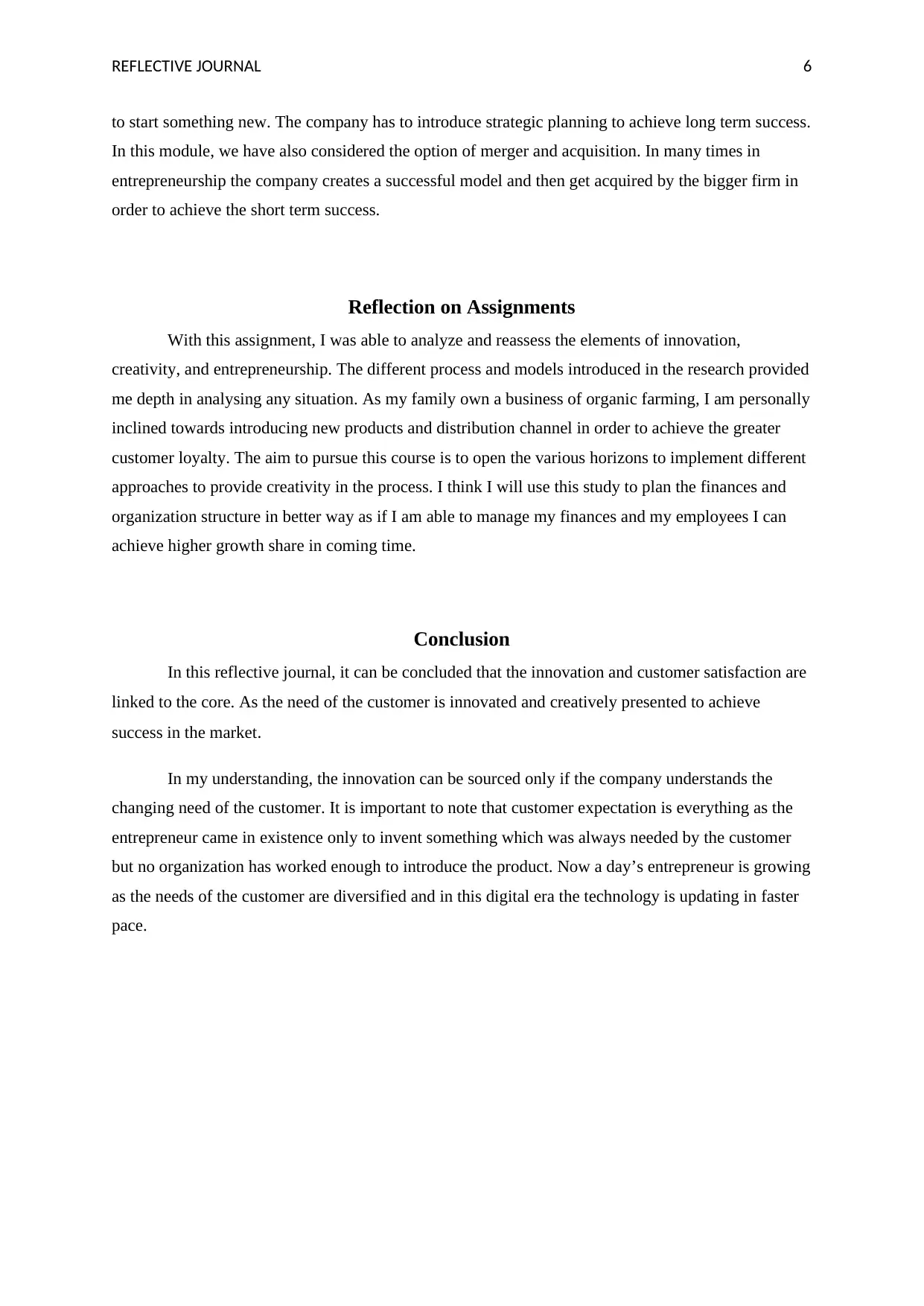
REFLECTIVE JOURNAL 6
to start something new. The company has to introduce strategic planning to achieve long term success.
In this module, we have also considered the option of merger and acquisition. In many times in
entrepreneurship the company creates a successful model and then get acquired by the bigger firm in
order to achieve the short term success.
Reflection on Assignments
With this assignment, I was able to analyze and reassess the elements of innovation,
creativity, and entrepreneurship. The different process and models introduced in the research provided
me depth in analysing any situation. As my family own a business of organic farming, I am personally
inclined towards introducing new products and distribution channel in order to achieve the greater
customer loyalty. The aim to pursue this course is to open the various horizons to implement different
approaches to provide creativity in the process. I think I will use this study to plan the finances and
organization structure in better way as if I am able to manage my finances and my employees I can
achieve higher growth share in coming time.
Conclusion
In this reflective journal, it can be concluded that the innovation and customer satisfaction are
linked to the core. As the need of the customer is innovated and creatively presented to achieve
success in the market.
In my understanding, the innovation can be sourced only if the company understands the
changing need of the customer. It is important to note that customer expectation is everything as the
entrepreneur came in existence only to invent something which was always needed by the customer
but no organization has worked enough to introduce the product. Now a day’s entrepreneur is growing
as the needs of the customer are diversified and in this digital era the technology is updating in faster
pace.
to start something new. The company has to introduce strategic planning to achieve long term success.
In this module, we have also considered the option of merger and acquisition. In many times in
entrepreneurship the company creates a successful model and then get acquired by the bigger firm in
order to achieve the short term success.
Reflection on Assignments
With this assignment, I was able to analyze and reassess the elements of innovation,
creativity, and entrepreneurship. The different process and models introduced in the research provided
me depth in analysing any situation. As my family own a business of organic farming, I am personally
inclined towards introducing new products and distribution channel in order to achieve the greater
customer loyalty. The aim to pursue this course is to open the various horizons to implement different
approaches to provide creativity in the process. I think I will use this study to plan the finances and
organization structure in better way as if I am able to manage my finances and my employees I can
achieve higher growth share in coming time.
Conclusion
In this reflective journal, it can be concluded that the innovation and customer satisfaction are
linked to the core. As the need of the customer is innovated and creatively presented to achieve
success in the market.
In my understanding, the innovation can be sourced only if the company understands the
changing need of the customer. It is important to note that customer expectation is everything as the
entrepreneur came in existence only to invent something which was always needed by the customer
but no organization has worked enough to introduce the product. Now a day’s entrepreneur is growing
as the needs of the customer are diversified and in this digital era the technology is updating in faster
pace.
Paraphrase This Document
Need a fresh take? Get an instant paraphrase of this document with our AI Paraphraser
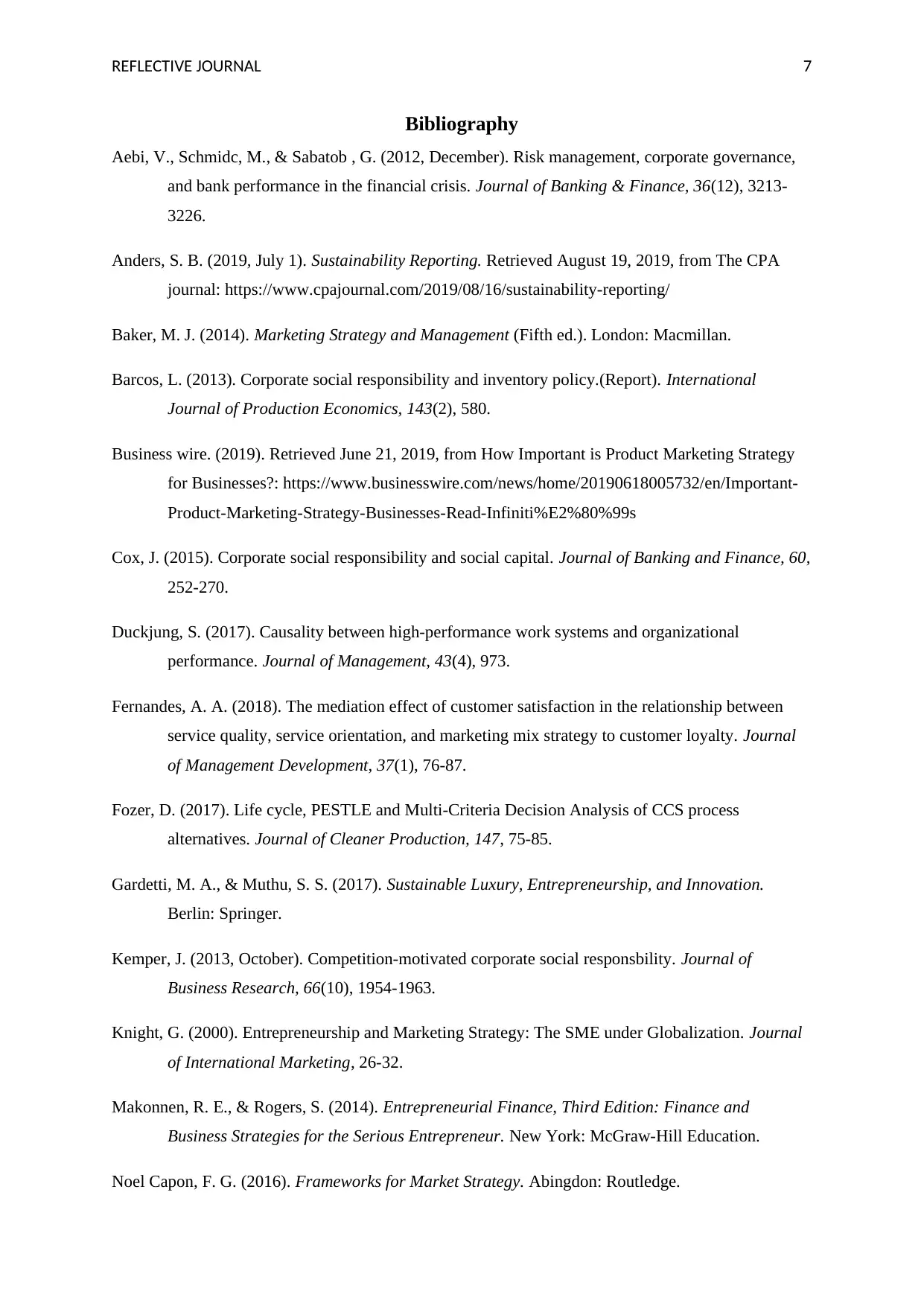
REFLECTIVE JOURNAL 7
Bibliography
Aebi, V., Schmidc, M., & Sabatob , G. (2012, December). Risk management, corporate governance,
and bank performance in the financial crisis. Journal of Banking & Finance, 36(12), 3213-
3226.
Anders, S. B. (2019, July 1). Sustainability Reporting. Retrieved August 19, 2019, from The CPA
journal: https://www.cpajournal.com/2019/08/16/sustainability-reporting/
Baker, M. J. (2014). Marketing Strategy and Management (Fifth ed.). London: Macmillan.
Barcos, L. (2013). Corporate social responsibility and inventory policy.(Report). International
Journal of Production Economics, 143(2), 580.
Business wire. (2019). Retrieved June 21, 2019, from How Important is Product Marketing Strategy
for Businesses?: https://www.businesswire.com/news/home/20190618005732/en/Important-
Product-Marketing-Strategy-Businesses-Read-Infiniti%E2%80%99s
Cox, J. (2015). Corporate social responsibility and social capital. Journal of Banking and Finance, 60,
252-270.
Duckjung, S. (2017). Causality between high-performance work systems and organizational
performance. Journal of Management, 43(4), 973.
Fernandes, A. A. (2018). The mediation effect of customer satisfaction in the relationship between
service quality, service orientation, and marketing mix strategy to customer loyalty. Journal
of Management Development, 37(1), 76-87.
Fozer, D. (2017). Life cycle, PESTLE and Multi-Criteria Decision Analysis of CCS process
alternatives. Journal of Cleaner Production, 147, 75-85.
Gardetti, M. A., & Muthu, S. S. (2017). Sustainable Luxury, Entrepreneurship, and Innovation.
Berlin: Springer.
Kemper, J. (2013, October). Competition-motivated corporate social responsbility. Journal of
Business Research, 66(10), 1954-1963.
Knight, G. (2000). Entrepreneurship and Marketing Strategy: The SME under Globalization. Journal
of International Marketing, 26-32.
Makonnen, R. E., & Rogers, S. (2014). Entrepreneurial Finance, Third Edition: Finance and
Business Strategies for the Serious Entrepreneur. New York: McGraw-Hill Education.
Noel Capon, F. G. (2016). Frameworks for Market Strategy. Abingdon: Routledge.
Bibliography
Aebi, V., Schmidc, M., & Sabatob , G. (2012, December). Risk management, corporate governance,
and bank performance in the financial crisis. Journal of Banking & Finance, 36(12), 3213-
3226.
Anders, S. B. (2019, July 1). Sustainability Reporting. Retrieved August 19, 2019, from The CPA
journal: https://www.cpajournal.com/2019/08/16/sustainability-reporting/
Baker, M. J. (2014). Marketing Strategy and Management (Fifth ed.). London: Macmillan.
Barcos, L. (2013). Corporate social responsibility and inventory policy.(Report). International
Journal of Production Economics, 143(2), 580.
Business wire. (2019). Retrieved June 21, 2019, from How Important is Product Marketing Strategy
for Businesses?: https://www.businesswire.com/news/home/20190618005732/en/Important-
Product-Marketing-Strategy-Businesses-Read-Infiniti%E2%80%99s
Cox, J. (2015). Corporate social responsibility and social capital. Journal of Banking and Finance, 60,
252-270.
Duckjung, S. (2017). Causality between high-performance work systems and organizational
performance. Journal of Management, 43(4), 973.
Fernandes, A. A. (2018). The mediation effect of customer satisfaction in the relationship between
service quality, service orientation, and marketing mix strategy to customer loyalty. Journal
of Management Development, 37(1), 76-87.
Fozer, D. (2017). Life cycle, PESTLE and Multi-Criteria Decision Analysis of CCS process
alternatives. Journal of Cleaner Production, 147, 75-85.
Gardetti, M. A., & Muthu, S. S. (2017). Sustainable Luxury, Entrepreneurship, and Innovation.
Berlin: Springer.
Kemper, J. (2013, October). Competition-motivated corporate social responsbility. Journal of
Business Research, 66(10), 1954-1963.
Knight, G. (2000). Entrepreneurship and Marketing Strategy: The SME under Globalization. Journal
of International Marketing, 26-32.
Makonnen, R. E., & Rogers, S. (2014). Entrepreneurial Finance, Third Edition: Finance and
Business Strategies for the Serious Entrepreneur. New York: McGraw-Hill Education.
Noel Capon, F. G. (2016). Frameworks for Market Strategy. Abingdon: Routledge.
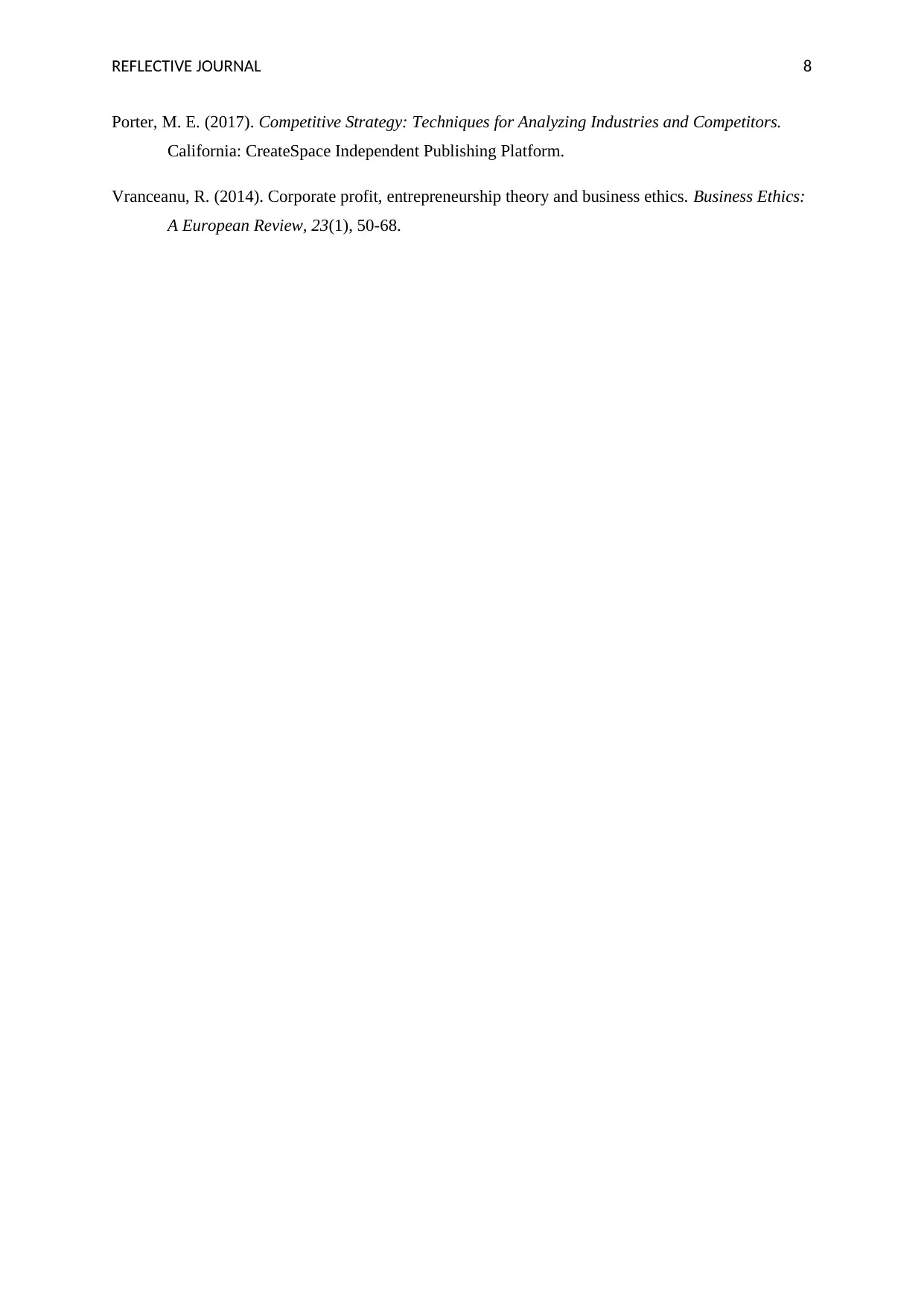
REFLECTIVE JOURNAL 8
Porter, M. E. (2017). Competitive Strategy: Techniques for Analyzing Industries and Competitors.
California: CreateSpace Independent Publishing Platform.
Vranceanu, R. (2014). Corporate profit, entrepreneurship theory and business ethics. Business Ethics:
A European Review, 23(1), 50-68.
Porter, M. E. (2017). Competitive Strategy: Techniques for Analyzing Industries and Competitors.
California: CreateSpace Independent Publishing Platform.
Vranceanu, R. (2014). Corporate profit, entrepreneurship theory and business ethics. Business Ethics:
A European Review, 23(1), 50-68.
⊘ This is a preview!⊘
Do you want full access?
Subscribe today to unlock all pages.

Trusted by 1+ million students worldwide
1 out of 9
Related Documents
Your All-in-One AI-Powered Toolkit for Academic Success.
+13062052269
info@desklib.com
Available 24*7 on WhatsApp / Email
![[object Object]](/_next/static/media/star-bottom.7253800d.svg)
Unlock your academic potential
Copyright © 2020–2025 A2Z Services. All Rights Reserved. Developed and managed by ZUCOL.





